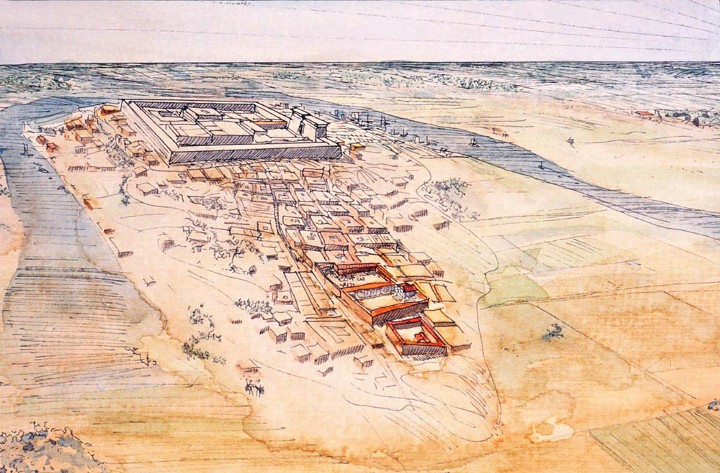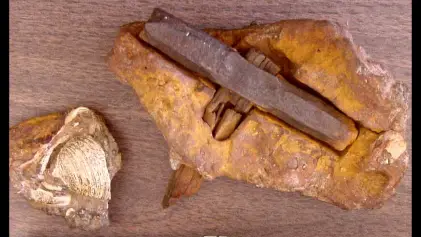 the area of the Nile river, near the villages of Rashwan and Abu Mishfa, there is a lake inhabited by countless egrets. Beneath this lake lies the ruins of the city of Naukratis, a Greek-founded city, which served as a trading port, somewhere around 620 BC. Specialists from the British Museum carefully researched the area, which is one of the most interesting discoveries of recent years, near the Nile river.
the area of the Nile river, near the villages of Rashwan and Abu Mishfa, there is a lake inhabited by countless egrets. Beneath this lake lies the ruins of the city of Naukratis, a Greek-founded city, which served as a trading port, somewhere around 620 BC. Specialists from the British Museum carefully researched the area, which is one of the most interesting discoveries of recent years, near the Nile river.
The lost trading center of the ancient world
Archaeologists consider the sunken city of Naukratis to be a Hong Kong of the ancient world in terms of the number of trades that were done in the ancient world as well as a large number of visitors (mainly traders) the city received. You would not imagine that a city in the middle of a desert would become very popular. It takes a real effort of imagination to place the flourishing city in this area, before being abandoned in the 7th century. Naukratis was home to over 16,000 people, a city full of temples dedicated to Greek gods, such as Hera or Aphrodite, but dominated by a vast sanctuary dedicated to the Egyptian supreme god, Amun Ra.
In the city, there was also a Hellenion, a sanctuary dedicated to all the Greek gods: an early expression of the Greek identity, adopted by the politically independent city-states, which according to the historian Herodotus, were established at the invitation of the Pharaoh. Greek temples initially started out as simple businesses, sacred enclosures with outdoor altars, later they acquired from the Egyptians the ability to build temples with columns. Around the sanctuaries were houses of squatters, but they had more floors.
All the Mediterranean traders who had business with Egypt were obliged to go through Naukratis. They sold oil and wine, and those wishing to continue their journey up the Nile to the port of Thonis-Heracleion were obliged to pay a tax. The city was also not only famous because of its merchants but also for its beautiful courtiers. There is a story in which the brother of the Greek poetess Sappho, Charaxos, fell in love with the beautiful courtesan Rhodopis, which he bought from her master and got married to.
The discovery of Naukratis
Naukratis was partially excavated in 1880 when archaeologist Flinders Petrie found an inscription in ancient Greek. Amphorae fragments, bowls for sauces, and thousands of other Egyptian ceramics were also found. At first glance, one would say that it was not a Greek colony, but the specialists assure us that Naukratis was a Greek city inhabited by a mixed community. During the first excavations, from the end of the 19th century, small statues of Siris and Osiris were also discovered.

There is no more impressive evidence of the interaction between the two cultures that lived in Naukratis than in the Egyptian Museum in Cairo. There resides a four-meter statue, which was found in the waters of the lake. Initially, visitors believe it is the statue of a pharaoh. Even though he is dressed like an Egyptian leader, he has rigid arms and was raised in the temple of Amun Ra, around 300 BC, his name according to the hieroglyphs on the back of the statue was Horemheb.
The inscription says in clear terms “I am Greek.” His father is a certain Krates, a Greek origin name, and his mother, Shesemtet. This is not the only piece of evidence showing the Greek origin but also, many different manuscripts that have been discovered in 2018 beneath the Nile. Despite all this, many historians still argue they refer to the origin of Naukratis as Egyptian and not Greek. I believe that even the name implies a Greek origin.
With such a strange phenomenon of the city being in an odd location to be believed as being of Greek origin and dating back God knows how many years ago, it is hard to really decrypt its true origin, but experts from University College London argue that the statue is of Greek origin, therefore the city if not built by the Greeks, may have been conquered by them at some point in time or even vice versa.
Avid Writer with invaluable knowledge of Humanity!
Upcoming historian with over 30 million views online.
“You make your own life.”





